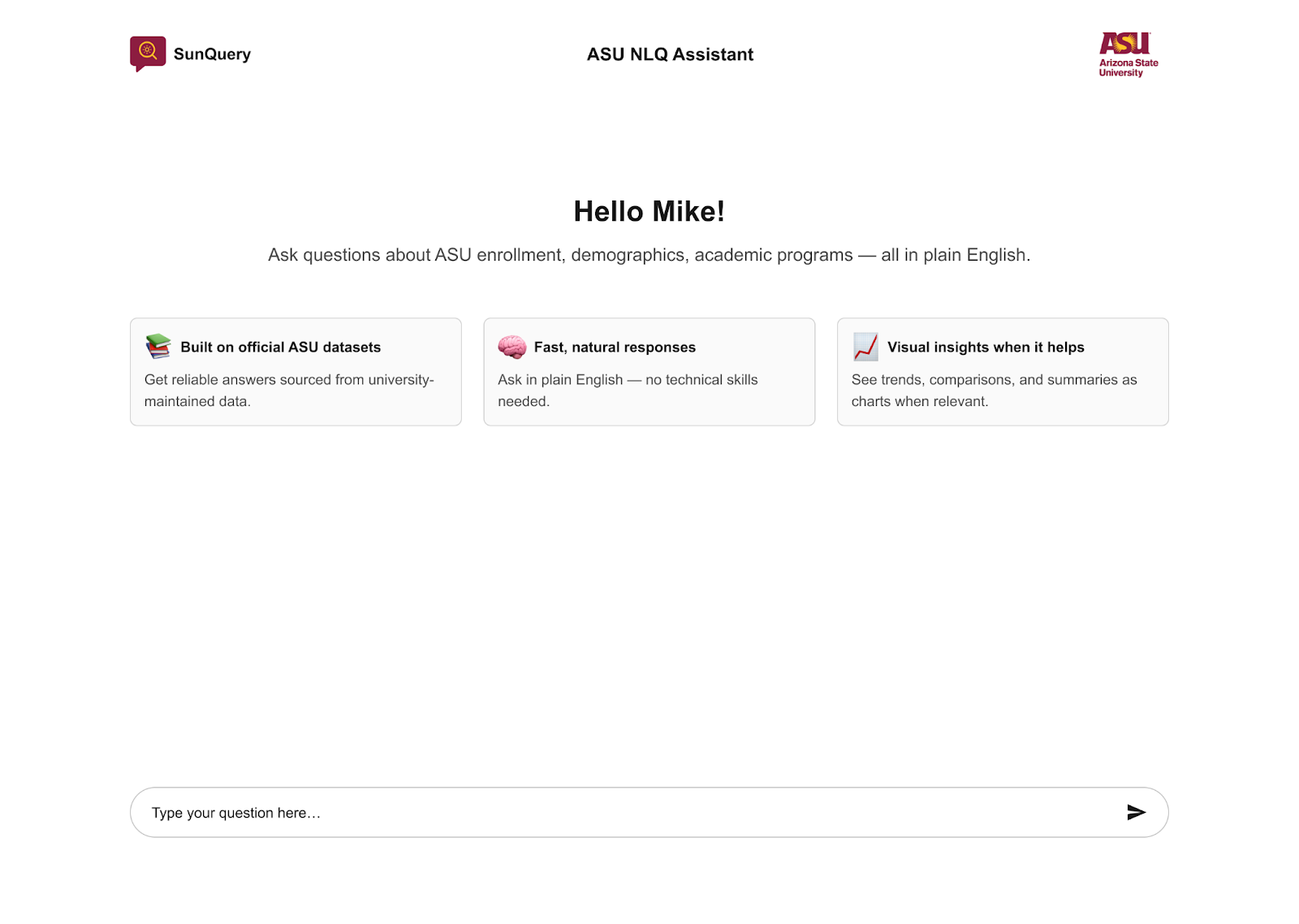
Natural Language Query: ASU
The Arizona State University Artificial Intelligence Cloud Innovation Center, powered by Amazon Web Services (AWS), collaborated with Arizona State University (ASU) Data and Analytics team to develop an innovative Natural Language Query (NLQ) system that transforms how staff access and explore institutional data. This initiative focused on creating a chatbot that can answer questions about ASU's structured datasets using natural language, reducing the need for technical SQL queries or complex dashboard navigation. The system was designed to be easily adaptable across different datasets, providing both public-facing capabilities for understanding the university and internal tools for staff to quickly access direct data insights from ASU's extensive data warehouse.
Problem
Arizona State University possesses massive datasets containing information about hundreds of topics, but accessing this valuable information required navigating complex dashboards or having technical expertise to write database queries. As AI chatbots emerged as common tools for information access, ASU recognized the need for a more intuitive solution that would allow both internal staff and potentially the public to ask natural language questions about university data.The challenge was creating a system that could understand a natural language question and then execute a database query that would return an accurate answer.
Approach
The team built two major components:
- A natural language query engine that classifies user questions, converts them to SQL queries, and retrieves accurate data responses from ASU's structured datasets.
- A swappable system architecture that can execute queries against different datasets without having to retrain the underlying LLM engine
The solution is powered by several key AWS services:
- Bedrock Nova Pro - Powers question classification, query improvement, and response generation using advanced AI
- Bedrock Knowledge Base - Manages retrieval augmented generation to create and execute SQL queries automatically
- AWS Lambda - Handles serverless compute orchestration for all chatbot operations
- Amazon Redshift - Stores and processes the structured institutional data
- API Gateway WebSocket - Enables real-time response streaming for better user experience
- Bedrock Guardrails - Scans input and output to ensure content safety and appropriateness
- AWS Amplify - Hosts the React frontend interface with ASU branding
The system processes user questions by first determining if a database query is needed, then creates an improved SQL-compatible question, retrieves relevant information, and generates a comprehensive response. Users can ask complex institutional questions in plain language and receive accurate, data-driven answers without technical expertise.
Industry Impact
This Natural Language Query system reframes how educational institutions can leverage their data assets. By removing technical barriers to data access, ASU staff members—including institutional researchers, administrators, and academic leadership—can now make faster, more informed decisions without waiting for data teams or learning complex query languages. The system enables self-service analytics that aligns with how people naturally think and ask questions about institutional data.The impact extends beyond operational efficiency to strategic planning and reporting capabilities. Staff can now explore data relationships, generate insights for decision-making, and access comprehensive institutional information through conversational interactions.
I found working with the ASU CIC to be an enjoyable and symbiotic experience. The CIC team was incredibly knowledgeable and brought the high level of expertise that I expected from an organization like this. I benefitted from this expertise, and I also notice that the team benefitted from tackling a problem like natural language querying. It’s relevant to the cutting edge AI and data work that AWS is known for, and it’s relevant to the Arizona State University community as we innovate in the higher ed data space.
Mike Sharkey, Executive Director of Data & Analysis, ASU Enterprise Technology
Wider Application
The swappable architecture developed for ASU offers significant potential for adaptation across higher education and beyond. Universities, government agencies, healthcare systems, and large organizations with extensive structured datasets can implement similar natural language query systems to unlock the value of their data repositories.
The system's design principle of dataset independence means it can be rapidly deployed across different data sources within an organization or adapted for entirely different sectors. Educational institutions facing similar challenges with data accessibility, research organizations managing complex datasets, and government agencies seeking to improve public data access can all benefit from this architectural approach.
Next Steps
Now that a working version of the NLQ bot has been developed, the next step is to conduct user testing to evaluate its accuracy and performance. Because precision is essential, the tool must be tested in real-world conditions to ensure it consistently provides correct responses. Allowing users to interact directly with the bot will help identify areas for improvement and strengthen overall reliability. The modular architecture also supports easy adjustments and ongoing maintenance, enabling Arizona State University to continue refining and expanding the solution with minimal overhead or administrative burden.
About the ASU CIC
The ASU Smart Cities Cloud Innovation Center (CIC) is a strategic relationship with Amazon Web Services (AWS) and is supported by AWS on ASU’s Innovation campus - SkySong. The mission of the CIC is to drive Innovation Challenges that materially benefit the greater Phoenix metro area and beyond. The CIC will do this by solving pressing community and regional challenges, using shareable and repeatable technology solutions from ideation through prototype, as a service for the greater human good.
The CIC also provides real-world problem-solving experiences to students by immersing them in the application of proven innovation methods in combination with the latest technologies to solve important challenges in the public sector.
The challenges being addressed cover a wide variety of topics including homelessness, water conservation, vandalism, pedestrian safety, digital service delivery and many others. The CIC leverages the deep subject matter expertise of government, education and non-profit organizations to clearly understand the customers affected by public sector challenges and develops solutions that meet the customer needs.
For more information on the ASU CIC, to read about projects or to submit a challenge, please visit https://smartchallenges.asu.edu.
Photos



